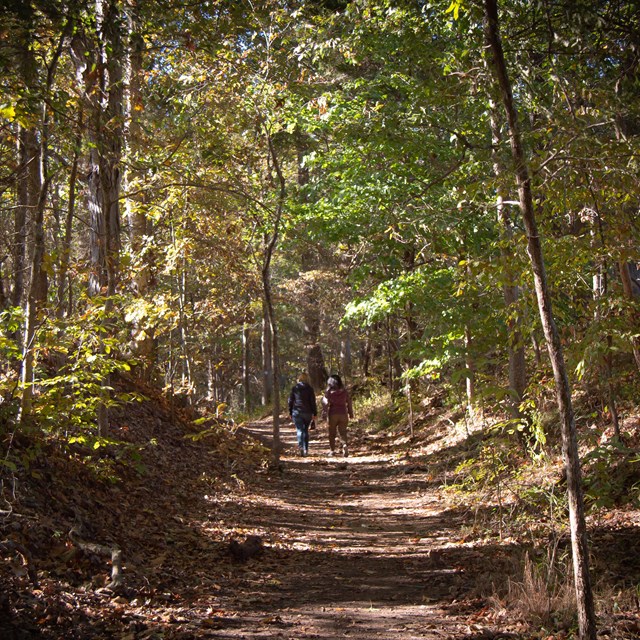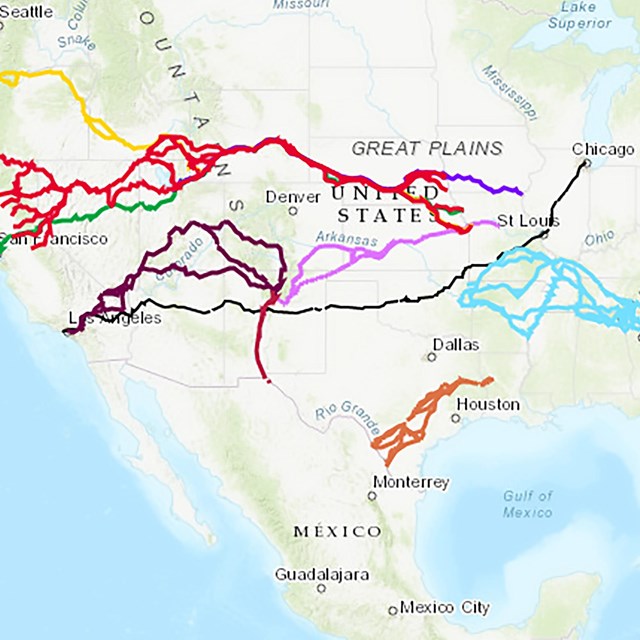Last updated: August 1, 2023
Article
Mantle Rock Preserve and the Trail of Tears
You can hike a portion of the Trail of Tears at The Nature Conservancy's Mantle Rock Preserve in Livingston County, Kentucky. The outdoor exhibits (featured in this article and available on site) guide the retracement experience.

They Passed This Way
... we have Suffered a great deal... The roads are in very bad Order as the ground was frozen very deep... We have been lying by about two weeks... The [river] has been full of large quantities of floating Ice... we must calculate on suffering a good deal from hardships & exposure before we yet reach our homes in the far West.
-Recollection of a survivor of the Trail of Tears
Retracing the Trail of Tears During that harsh winter, 11 detachments containing more than 10,000 Cherokee passed through the Mantle Rock area, not even halfway to Indian Territory. One of those groups, the Peter Hildebrand Detachment, was forced to spend two bitterly cold weeks in the Mantle Rock area, encamped for miles along the road.
They were waiting for the frozen Ohio River to thaw enough for the ferry to carry people from Berry’s Ferry, Kentucky, to Golconda, Illinois. Once across the river, many became trapped again between the frozen Ohio and Mississippi rivers until they could continue traveling west to Indian Territory. These 11 detachments left Tennessee in 1838 with over 10,000 Cherokee, but due to exhaustion, illness and death, they numbered hundreds less when they arrived in Oklahoma.

NPS map
Walk in Their Footsteps...
The Cherokee walked the road that is now a hiking trail at Mantle Rock Preserve, halfway through an 800 mile journey, feeling the loss of homeland and unsure of what lay ahead. Over 10,000 men, women, and children traveled this road during the winter of 1838-1839. When visiting Mantle Rock Preserve, you can walk in their footsteps and think of their experience as you hike the trail.
The Indians as a whole carry in their countenances every thing but the appearance of happiness. Some carry a downcast dejected look bordering on the appearance of despair...
- New York Observer, January 26, 1839
Winter Camp
We found them in the forest camped for the night by the road side under a severe fall of rain accompanied by heavy wind. With their canvas for a shield from the inclemency of the weather, and the cold wet ground for a resting place, after the fatigue of the day, they spent the night.
We met several detachments in the southern part of Kentucky... two thousand Indians with horses and mules in proportion. The forward part of the train we found just pitching their tents for the night, and notwithstanding some thirty or forty wagons were already stationed, we found the road literally filled with the procession for about three miles in length.
- New York Observer, January 26, 1839

Witness to History
The tree pictured was only a seedling when the Cherokee paused here. Imagine the scene — it was a tree like this one that a weary Cherokee man sat against in a winter camp. His family struggled to make a simple, warm, resting place for this family elder, trying to keep him comfortable while they waited two weeks for the river to thaw and their journey to continue.
Many of the aged Indians were suffering extremely from the fatigue of the journey, and the ill health consequent upon it. Several were then quite ill, and one aged man we were informed was then in the last struggles of death.
-New York Observer, January 26, 1839
The Real Story of Mantle Rock
Mantle Rock is the largest freestanding arch east of the Mississippi River. It is 188 feet long and 30 feet high. Some of the plants found here are not known to grow anywhere else in Kentucky. This very beautiful and historic place has many stories to tell. It is impossible to know how many Cherokee saw Mantle Rock when they walked along the historic road north of here. Thousands of Cherokee passed this way, waiting in winter for a safe river crossing. Many lived in temporary camps that stretched for miles along the road. Exhausted by journey, and staying near supplies and wagons on the road, it is unlikely that many visited Mantle Rock itself.
Some stories tell that the Cherokee camped under Mantle Rock. There were far too many Cherokee to camp under the arch, and historical descriptions describe a long, linear camp along the road.
Other stories suggest that there were burials under Mantle Rock. The Trail of Tears claimed many lives, but there is no evidence of burials at Mantle Rock.
The sandstone glade on top of the arch is one of the highest quality glades in the state. It has been estimated that less than one percent of these habitats remain, but here they are protected.

NPS Image
The Trail of Tears
Federal Indian Removal Policy
Federal Indian removal policy aroused fierce and bitter debate. Supporters of the policy claimed it was a benevolent action to save the tribes east of
the Mississippi River from being overwhelmed and lost in the onslaught of an expanding American population. Opponents decried its inhumanity and the tragic consequences it had for the Indian peoples. One thing was certain; removal freed millions of acres of desired Indian lands for use by white settlers.
The Indian Removal Act of 1830 resulted in the removal of thousands of American Indians from their ancestral lands for new homes in Indian Territory
(present-day Oklahoma). They traveled by existing roads and rivers. Many groups, hoping to avoid the disease and heat of summer travel, left in the fall and instead faced treacherous winter weather. Many died during the ordeal of the Trail of Tears.
Today
Despite the hardships of the journey, members of the five removed tribes established new lives in the West. They stand as successful sovereign nations, proudly preserving cultural traditions, while adapting to the challenges of the 21st century.
Cherokee who survived the Trail of Tears created a new sovereign nation in present-day Oklahoma. Some Cherokee remained in North Carolina and due to a special exemption formed the Eastern Band of Cherokee Indians

NPS Image


